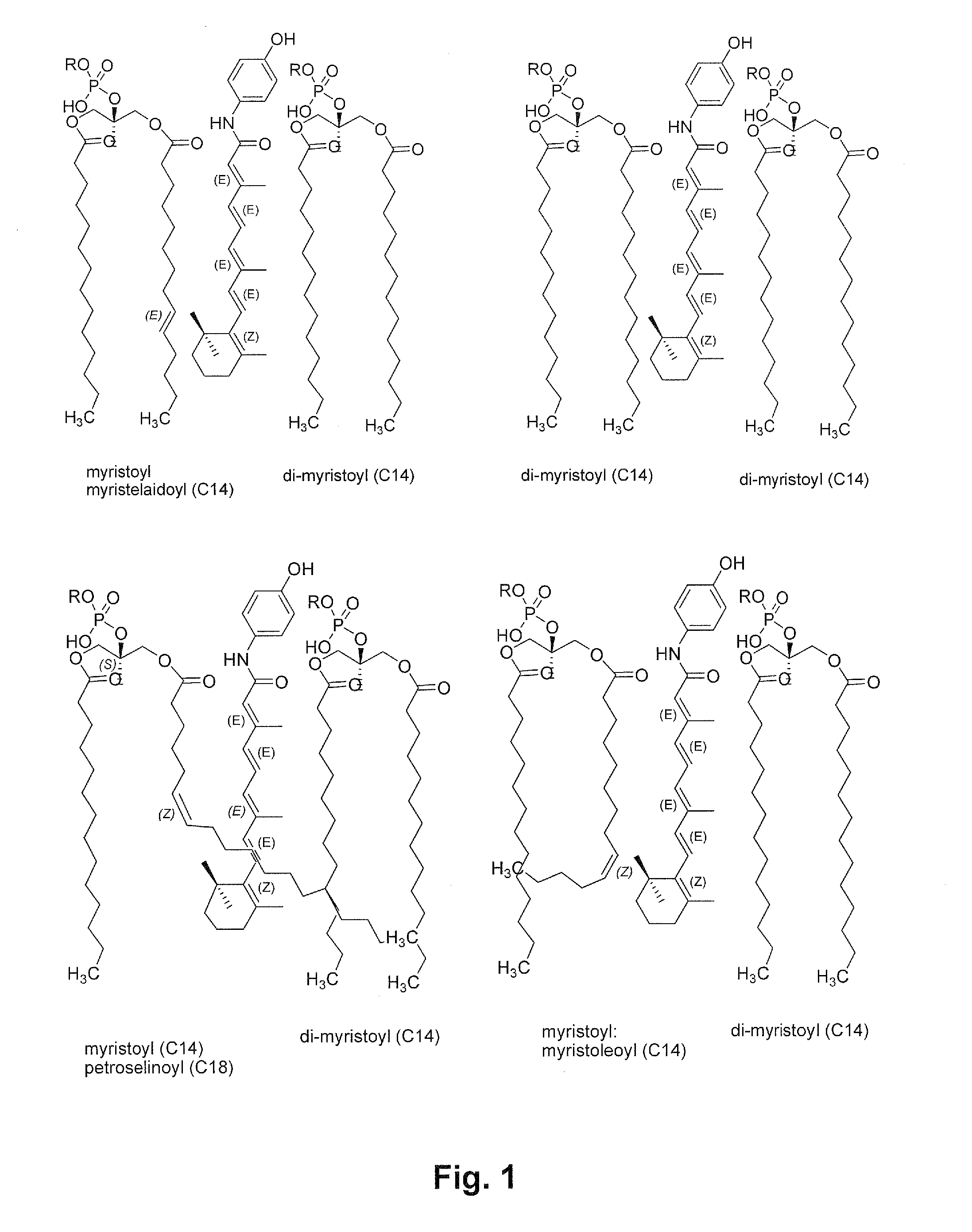Liposomal nanoparticles and other formulations of fenretinide for use in therapy and drug delivery
a technology of fenretinide and nanoparticles, which is applied in the field of pharmaceutical science and biomedicine, can solve the problems of limited usefulness of hpr as a chemotherapeutic, slowing down time, co-polymer and solid dispersion, etc., and achieves excellent safety profile and improves therapeutic
- Summary
- Abstract
- Description
- Claims
- Application Information
AI Technical Summary
Benefits of technology
Problems solved by technology
Method used
Image
Examples
example 1
Type 1. Free-Flowing Lipid Nanosystem
[0202]Type 1. Free-flowing lipid nanosystems were prepared by hand using research grade soy lecithin (in particular a formulation designated F23 that was the lead formulation demonstrating in vivo efficacy against human tumors). Such free-flowing lipid nanosystems of HPR substantially increased the water solubility of HPR to as high as 50-60 mg / ml, more than 1000-× its natural water solubility. These free flowing nanosystems can be prepared generally using the following approach.
[0203]HPR, research grade soy lecithin (or other source of phosphatidyl lipid), BHT (or other appropriate antioxidant to protect the HPR from oxidation), and cholic acid (or another appropriate additive that physically stabilizes the lecithin nanodispersion and facilitates particle formation, are dissolved in a 1:1 mixture of methanol:chloroform and the solvents removed under vacuum, preferably in a rotating evaporation flask so that the materials are deposited as a thin ...
example 2
Type 2 Free flowing Lipid Nanosystem Based on Lecithin
[0210]Type 2 free flowing lipid nanosystems were prepared using scalable pharmaceutical manufacturing techniques and processes, especially lecithin-based preparations from an ethanol+dichloromethane (DCM;=methylene chloride or CH2Cl2) solvent.
[0211]Similar preparations of highly soluble HPR in soy lecithin can also be prepared after solubilizing the lipid ingredients in different solvents than methanol plus chloroform. For example, a preparation of water soluble HPR at ˜11.4 mg / ml was produced from a lipid film made from drying a 1:1 solvent mixture of ethanol: DCM. To prepare this, 5400 mg L-α-phosphatidylcholine and 300 mg sodium cholate were added to a rotary evaporation round bottom flask, to which was then added 60 ml of a 1:1 mixture of DCM:ethanol, and sonicated until the materials dissolved. Then, 300 μl of a 4 mg / mL solution of BHT in ethanol was added to the flask and dissolved by hand swirling. Next, 750 mg of HPR was ...
example 3
Type 3—Free Flowing Lipid Nanosystems of Phosphatidyl Lipids
[0215]Type 3—free flowing lipid nanosystems were prepared using scalable pharmaceutical manufacturing techniques and processes that contained shorter-chain phosphatidyl lipids as a substitute for the cholic acid / cholate salt ingredient
[0216]Natural soy lecithin (natural L-α-phosphatidylcholine”) contains predominantly C16 and C18 fatty acid side chains covalently attached to the C-1 and C-2 carbons of the glycerol backbone of the lecithin molecule. The C16 fatty acids are commonly saturated. The C18 fatty acids are commonly unsaturated, with one or more double bonds in the carbon atom backbone.
[0217]The HPR formulations prepared using natural soy lecithins from various sources would be expected to show similar compositions. It is possible to use chemically-defined phosphatidyl choline lipids with shorter chain fatty acids than C16 or C18 on the C-1 and C-2 positions of the glycerol backbone as a substitute / replacement for c...
PUM
| Property | Measurement | Unit |
|---|---|---|
| Length | aaaaa | aaaaa |
| Length | aaaaa | aaaaa |
| Fraction | aaaaa | aaaaa |
Abstract
Description
Claims
Application Information
 Login to View More
Login to View More - R&D
- Intellectual Property
- Life Sciences
- Materials
- Tech Scout
- Unparalleled Data Quality
- Higher Quality Content
- 60% Fewer Hallucinations
Browse by: Latest US Patents, China's latest patents, Technical Efficacy Thesaurus, Application Domain, Technology Topic, Popular Technical Reports.
© 2025 PatSnap. All rights reserved.Legal|Privacy policy|Modern Slavery Act Transparency Statement|Sitemap|About US| Contact US: help@patsnap.com



